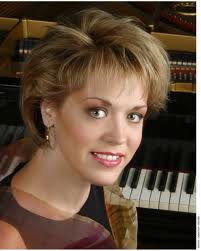|
Symphony
SRS SEASON ENDS WITH RESOUNDING TA-TA-TA-BANG
by Terry McNeill
Sunday, June 1, 2025
Symphony
YOUTHFUL VIRTUOSITY ON DISPLAY AT USO'S MAY CONCERTS
by Peter Lert
Saturday, May 17, 2025
Symphony
MYSTICAL PLANETS AND LIVELY GERSHWIN ORTIZ AT FINAL SRS CONCERT
by Peter Lert
Sunday, May 4, 2025
Symphony
VSO'S CONCERT MUSIC OF TIME, MUSIC OF PLACE
by Peter Lert
Sunday, April 27, 2025
Choral and Vocal
VOCAL ELEGANCE AND FIRE AT THE 222'S RECITAL APRIL 26
by Pamela Hicks Gailey
Saturday, April 26, 2025
CANTIAMO SONOMA SINGS AN INSPIRED GOOD FRIDAY MOZART REQUIEM CONCERT
by Pamela Hicks Gailey
Friday, April 18, 2025
DRAMATIC SHOSTAKOVICH SYMPHONY CLOSES PHILHARMONIC'S 25TH SEASON
by Terry McNeill
Sunday, April 13, 2025
LARGE COLLEGE OF MARIN AUDIENCE GREETS STOPHER ARTISTRY
by Terry McNeill
Saturday, April 5, 2025
Chamber
FRISSON DELIVERS SHIVERS OF DELIGHT
by Abby Wasserman
Sunday, March 30, 2025
OLD AND MOSTLY NEW IN SRS MARCH CONCERT IN WEILL
by Peter Lert
Saturday, March 22, 2025
|
 |
 Pianist Olga Kern |
A PERFECT 10 FOR THE TENTH
by Steve Osborn
Saturday, May 11, 2013
The Santa Rosa Symphony capped off its first year in the resplendent Green Music Center with an impassioned performance of Shostakovich's Tenth Symphony, widely regarded as his masterpiece in the genre. Every section of the orchestra, from the lowest bass to the most stratospheric piccolo, played to the max, producing a lush, dense sound that filled the GMC's nearly full Weill Hall almost to bursting point.
The Shostakovich was a highlight of the season, matching or exceeding memorable performances earlier in the year of Berlioz's "Symphonie Fantastique," Mahler's Symphony No. 1, and Brahms' Symphony No. 3. In one sense, it was better than all of those, because--despite being 60 years old--it was probably new to most of the audience and made a strong case for the glories of modern repertoire.
Conductor Bruno Ferrandis chose an all-Russian program to build up to the Shostakovich. The concert opened with the all-too-brief prelude to "Khovanshchina," by Mussorgsky. Subtitled "Dawn on the Moscow River," this intensely lyrical work opens with a hushed figure in the violas that moves through the other strings and migrates to the clarinet, oboe and English horn. The playing was both ethereal and soothing, in keeping with the music's program. Sadly, it was over all too soon, ending up as more of a song than a full orchestral piece.
The full-blown orchestra arrived with the next number, Rachmaninoff's oft-performed Piano Concerto No. 2, this time with Russian pianist Olga Kern, winner of the 2001 Van Cliburn Competition. She entered from stage right in a floor-length red dress with a semi-open back, but her subsequent performance never quite matched the implicit fire of her bodily decor. She sat stiffly on the piano bench, her shoulders slightly stooped, her eyes fixated on the keyboard. In a work of intense Romanticism, she seemed to be more of an observer than a participant.
Kern's playing in the first movement lacked both projection and fluidity. She was often buried by the orchestra, and her phrases were disconnected. Instead of flowing into each other, they seemed isolated--fragments instead of a complete entity. The second movement was better, but again the piano didn't ring out, and the playing lacked fire. It was only in the third, with its unflaggingly popular melody, that Kern finally came to life, articulating each recurrence of the theme with authority and technical dazzle.
The relative disappointment of the Rachmaninoff was soon forgotten in the magnificent opening bars of the Shostakovich. Using the simplest of means--the first three notes of the minor scale--Shostakovich crafts a riveting and suspenseful tale, as the three-note figure begins in the cellos and moves throughout the orchestra, pausing briefly for a gorgeous clarinet solo, ably played here by Roy Zajac. The inexorable forward motion continues, leading to an arresting fortissimo section followed by a long decrescendo.
The playing throughout the movement was exemplary, nowhere more so than in a luscious post-fortissimo clarinet duet between Zajac and his colleague Mark Wardlaw. The duet led into an obsessive waltz highlighted by crisp unanimity from the strings, and then into a haunting conclusion for piccolo and drums.
If the first movement displayed the Symphony's expressive capabilities, the second showed off their ability to play at top speed with an unflagging beat. Ferrandis launched them into a relentless perpetual motion at top volume, and they never let up. The effect was both dazzling and intense.
Speed gave way to Shostakovich's elegantly simple phrases in the third movement, marked Allegretto. Sounding much like a string quartet, the fiddles and their kin acted as a perfect foil for beguiling solos from French hornist Alex Camphouse and English hornist Bennie Cottone. Despite the relatively slow tempo, the forward motion was compelling, thanks to Ferrandis's steady beat.
Both Shostakovich and the Symphony saved the best for last, with a thoroughly convincing reading of the final movement. The pace was again furious, and the pulse evident at all times. Ferrandis exerted great dynamic control, easing into pianissimos with as much authority as fortissimos. The many solos from woodwinds and brass were all well played, making the work a virtual concerto for orchestra. When it came, the ending was sheer drama. It was a great way to end the season, and it bodes well for the season to come.
[Reprinted by permission of San Francisco Classical Voice.]
|
